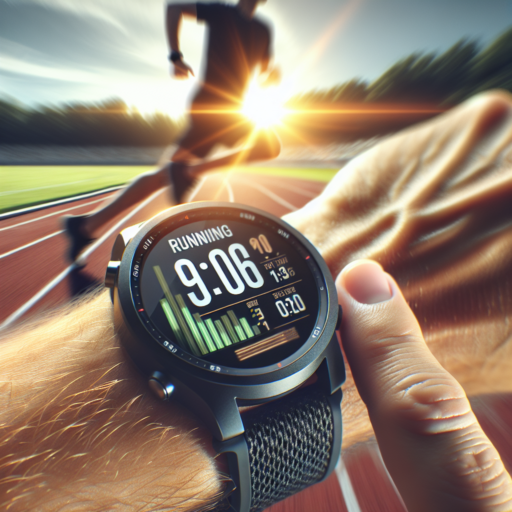Introduction to Heart Monitor Straps
Heart monitor straps have emerged as an essential tool for athletes and fitness enthusiasts aiming to optimize their workouts through precise heart rate tracking. These devices, worn around the chest, provide real-time data allowing for an accurate measure of cardiovascular performance. In this introduction to heart monitor straps, we delve into their functionality and the immense benefits they offer towards customizing and improving exercise routines.
At their core, heart monitor straps work by detecting electrical signals generated by the heart as it beats. This information is then transmitted to a connected device, such as a sports watch or a smartphone, enabling users to monitor their heart rate in live time. This capability is crucial for those looking to train within specific heart rate zones, whether the goal is fat burning, endurance enhancement, or peak performance training.
The evolution of heart monitor straps from bulky, uncomfortable units to sleek, lightweight designs has significantly increased their popularity among the athletic community. Today’s models not only offer comfort but also boast high accuracy and compatibility with a wide range of training devices and apps. This adaptability ensures that regardless of your preferred exercise modality—be it running, cycling, swimming, or strength training—there is a heart monitor strap designed to meet your needs.
Types of Heart Monitor Straps Available
When it comes to tracking heart rate, the precision and comfort of the monitoring device play pivotal roles. Heart monitor straps are a popular choice for athletes, fitness enthusiasts, and anyone interested in maintaining a healthy lifestyle. These devices offer real-time data, allowing for adjustments in workout intensity, recovery, and overall health management. Here, we’ll explore the various types of heart monitor straps available, highlighting their unique features and applications.
Chest Strap Monitors
Chest strap monitors are known for their accuracy and reliability. They are worn around the chest, just below the breastplate, which is an ideal location for detecting the electrical activity of the heart. Most of these devices use ANT+ and Bluetooth technology, making them compatible with smartphones, sports watches, and gym equipment. Their design focuses on ensuring minimal slippage during intense activities, hence providing continuous, real-time heart rate data.
Optical Heart Rate Monitors
Another innovative approach is seen in optical heart rate monitors, which can be worn on the wrist, arm, or even a finger. These devices use light-based technology to detect blood volume changes in the skin, thereby calculating the heart rate. While not as accurate as chest straps, particularly in high-intensity workouts, they offer greater comfort and are preferred for day-to-day wear. Optical heart rate monitors are especially appealing to those looking for a balance between functionality and convenience.
Each type of heart monitor strap has its own merits, tailored to suit different preferences and requirements. Whether it’s the high accuracy and reliability of chest straps or the convenience and comfort of optical monitors, users have a variety of options to support their heart health and fitness goals. By understanding the different types available, individuals can make informed decisions on which heart monitor strap best aligns with their health and fitness journey.
How to Choose the Right Heart Monitor Strap
Choosing the right heart monitor strap is essential for tracking your heart rate accurately during exercise or daily activities. With numerous options available, it’s important to consider several factors to find the best match for your needs.
Comfort and Fit
The comfort and fit of the heart monitor strap are crucial for continuous wear. A good strap should be made of a soft, flexible material that doesn’t irritate your skin or cause discomfort. Moreover, ensure the strap is adjustable to fit snugly around your chest without being too tight or too loose. An ill-fitting strap not only causes discomfort but also leads to inaccurate heart rate readings.
Compatibility
Before making a purchase, check the compatibility of the heart monitor strap with your devices. Most straps are designed to work seamlessly with various fitness watches, smartphones, and other devices, using Bluetooth or ANT+ technology for connectivity. However, to avoid disappointment, verify that the strap can connect with the specific models and brands of your devices. This ensures that you can accurately track and record your heart rate data across all your preferred platforms.
Features and Accuracy
Look for a heart monitor strap that not only fits well and is compatible with your devices but also offers high accuracy and additional features. Some straps include built-in memory for standalone use, water resistance for swimming, and replaceable batteries for extended life. Straps that offer real-time heart rate data, alongside measures such as heart rate variability (HRV), can provide more comprehensive insights into your overall fitness and wellness.
Benefits of Using a Heart Monitor Strap During Exercise
Exercising is not just about the amount you do but also about how effectively it’s done. A heart monitor strap serves as a critical tool in ensuring your workouts are hitting the mark for your fitness goals. By wearing one, you can unlock a range of benefits that make every sweat session more productive.
Enhanced Performance Tracking
One of the primary advantages of utilizing a heart monitor strap during your workouts is the enhanced performance tracking it offers. By delivering real-time data on your heart rate, it allows you to adjust your intensity levels on the fly to stay within your optimal training zone. This leads to more efficient workouts, whether you’re aiming for fat loss, endurance improvement, or strength gains. The instant feedback helps in fine-tuning your efforts, ensuring that you are not over or under-training.
Prevents Overtraining and Injuries
Overexertion is a common pitfall for athletes and fitness enthusiasts alike, often leading to overtraining and injuries. A heart monitor strap plays a crucial role in preventing these setbacks. By keeping an eye on your heart rate, you can avoid pushing yourself too hard and risking injury. This is especially critical for individuals returning to exercise after a period of inactivity or those with pre-existing health conditions. The strap acts as a personal coach, reminding you when to push harder or take it easy, promoting a safer workout environment.
Improved Heart Health
Regular use of a heart monitor strap during exercise not only enhances your fitness levels but also contributes significantly to your overall heart health. It helps in identifying heart rate patterns that may signal underlying issues, enabling timely medical consultation. Moreover, by ensuring that you are exercising within your heart rate target zone, it maximizes cardiovascular benefits and boosts your heart’s efficiency. Keeping your heart rate in check is paramount, and a monitor strap equips you with the knowledge to optimize your heart’s health and performance.
How to Wear and Maintain Your Heart Monitor Strap
Wearing your heart monitor strap correctly is crucial for obtaining accurate heart rate data, whether you’re an athlete looking to optimize your training or you’re monitoring your heart health. The strap should sit snugly below your chest muscles, and the sensor should be centered on your sternum. It’s essential for the strap to have good skin contact; therefore, moistening the electrodes on the back of the strap can improve connectivity and the accuracy of the data collected.
For maintenance, keeping your heart monitor strap clean is key to its longevity and continued accuracy. After each use, detach the sensor (if it’s detachable) and rinse the strap under running water. Every few weeks, it’s advised to hand wash the strap using a mild soap solution to remove any sweat or oil buildup, which can deteriorate the strap material over time and affect its function. Rinse thoroughly and allow it to air dry away from direct sunlight.
It’s equally important to regularly check the battery and replace it as needed to ensure your heart monitor continues to function correctly. Avoid storing the strap in extreme temperatures or in direct sunlight, as this can damage the materials and affect the sensor’s performance. For optimal use, ensure the firmware of your heart monitor is always up to date if it syncs with an app or a device.
No se han encontrado productos.
Top Heart Monitor Strap Brands Reviewed
Finding the right heart monitor strap can be a game-changer for athletes, fitness enthusiasts, and anyone looking to track their heart health accurately. With the plethora of options available in the market, we have reviewed the top heart monitor strap brands to help you make an informed decision. These brands have been selected based on their accuracy, comfort, compatibility, and user feedback.
Garmin: The Leader in GPS Technology
Garmin stands out for its high-quality heart monitor straps, emphasizing durability and precision. Their straps are known for exceptional connectivity with various devices and long battery life, making them a top choice for serious athletes. Garmin’s straps often feature advanced analytics, such as heart rate variability, to offer a detailed insight into your fitness levels.
Polar: Precision and Comfort
Polar is another brand that has earned respect in the heart rate monitoring space. Focusing on comfort and precision, Polar’s straps are soft and adjustable, ensuring they can be worn for extended periods without discomfort. Their heart monitor straps integrate seamlessly with a wide range of devices, including smartphones and sports watches, providing real-time data that helps in optimizing your training sessions.
Wahoo: Connectivity and Ecosystem
Wahoo excels in creating a connected ecosystem for its users, with heart monitor straps that boast excellent compatibility with third-party apps and devices. The brand prioritizes making every heartbeat count, offering straps that are not only accurate but also incredibly responsive. Wahoo’s products stand out for their ease of use, making them suitable for both beginners and professional athletes.
Integrating Your Heart Monitor Strap with Fitness Apps
Integrating your heart monitor strap with fitness apps can be a game-changer in tracking your physical activities and optimizing your workouts. Compatible fitness apps can take the data captured by your heart monitor strap and transform it into insightful analytics. This integration allows you to monitor your heart rate in real-time, offering a comprehensive view of your cardiovascular performance during different exercises.
Most heart monitor straps now offer Bluetooth or ANT+ connectivity, making it easier to pair them with a variety of fitness apps. Once connected, these apps can help you set heart rate zones, track your progress over time, and even provide customized workout plans based on your current fitness level and goals. It’s important to choose a fitness app that is compatible with your heart monitor strap and meets your specific needs for monitoring and improving your fitness.
To ensure seamless integration, follow the instructions provided with your heart monitor strap closely. Most straps will require you to download the corresponding app or connect to third-party apps within their settings. It is crucial to keep both the strap’s firmware and your chosen fitness app updated to enjoy uninterrupted data syncing and access the latest features.
Common Issues and Troubleshooting for Heart Monitor Straps
Heart monitor straps are indispensable tools for athletes and health-conscious individuals, keeping track of heart rate readings with accuracy during physical activities. However, encountering issues with these devices is not uncommon. Understanding common problems and knowing how to troubouldset them effectively can ensure they continue to serve as reliable fitness companions.
Ensuring Proper Contact and Fit
One of the most frequent issues users face with heart monitor straps is poor contact, which can lead to inaccurate readings or even loss of signal. Ensuring the strap is snugly fitted and maintains good skin contact is crucial. Moistening the contact points before use can improve connectivity, enhancing the strap’s ability to monitor the heart rate accurately. Regularly cleaning the strap according to the manufacturer’s instructions also prevents build-up of salts and oils, which can interfere with signal transmission.
Battery and Connectivity Issues
Another common concern is related to the battery and connectivity. A low or dead battery can be the culprit behind a non-responsive heart rate monitor. Replacing or recharging the battery, depending on the model, can quickly resolve this issue. Furthermore, ensuring the device is correctly paired with any external displays or apps is fundamental. Users should verify the compatibility of their heart monitor straps with all connected devices and ensure all software is up-to-date to avoid connectivity problems.
Remember, while heart monitor straps are powerful tools for monitoring health and fitness, like any technology, they are not immune to problems. By proactively addressing issues related to fit, contact, battery, and connectivity, users can minimize disruptions and maintain the effectiveness of their heart rate monitoring efforts.
Heart Monitor Strap: User Experiences and Success Stories
The evolution and widespread adoption of Heart Monitor Straps have revolutionized the way athletes, fitness enthusiasts, and individuals with health concerns approach their daily activities and training routines. Drawing from a diverse pool of user experiences, it’s clear that these devices have had a significant, positive impact on many lives.
One of the most compelling aspects of Heart Monitor Straps is their ability to provide real-time feedback on an individual’s heart rate, allowing for adjustments in workout intensity on the fly. Users often share stories of how this feature has been instrumental in preventing over-exertion and in promoting more efficient and safer workouts. Furthermore, the data collected by these devices supports personalized fitness plans, contributing to their overall success in achieving specific health and fitness goals.
Success stories are peppered with accounts of individuals who, with the aid of their Heart Monitor Straps, have seen remarkable improvements in their cardiovascular health, weight management, and energy levels. The precision and accuracy of these devices give users a deeper understanding of their body’s responses to different exercises and activities, empowering them to make informed decisions about their health and fitness journey.




